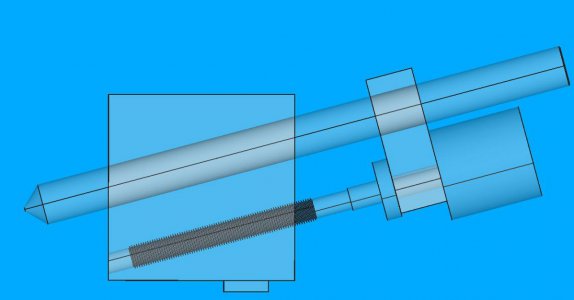- Joined
- Dec 18, 2019
- Messages
- 7,430
Have a piece that I want to make for a diamond dresser for my carbide grinder. It's about 6 inches long. But there are long sections that are around 1/4" diameter. I don't have an ER40 chuck yet for my lathe, so choking up on the rod and then pulling it outwards after machining isn't an easy option. However, I do have a 4 Jaw chuck for this lathe. Base stock is 1" diameter 12L14.
What would you recommend as an order of operations? The rod is about 12" long, so there's plenty for the chuck to hold onto. Planning to use a live center. Was thinking of sequentially turning it, to minimize deflection. Here's notionally what I am thinking of doing. Was hoping not to move the rod at all for this.
1. Start with turning down for the threads and some of the gutter
2. Single point the threads (1/4"-40)
3. Lengthen the gutter and turn the shank prior to the locating ring
4. Turn the locating ring diameter from the thread side of the ring to the edge of the knob (16.3 mm OD)
5. Turn the the 12.75 mm long section to 6.3 mm
6. Finish the knob, turn to diameter and knurl
Is this sensible? Or do you recommend a different approach? Thanks. Rather not have to do this 3 times! For context, the screw will be used in this assembly.

Thanks for any and all suggestions!
What would you recommend as an order of operations? The rod is about 12" long, so there's plenty for the chuck to hold onto. Planning to use a live center. Was thinking of sequentially turning it, to minimize deflection. Here's notionally what I am thinking of doing. Was hoping not to move the rod at all for this.
1. Start with turning down for the threads and some of the gutter
2. Single point the threads (1/4"-40)
3. Lengthen the gutter and turn the shank prior to the locating ring
4. Turn the locating ring diameter from the thread side of the ring to the edge of the knob (16.3 mm OD)
5. Turn the the 12.75 mm long section to 6.3 mm
6. Finish the knob, turn to diameter and knurl
Is this sensible? Or do you recommend a different approach? Thanks. Rather not have to do this 3 times! For context, the screw will be used in this assembly.

Thanks for any and all suggestions!
